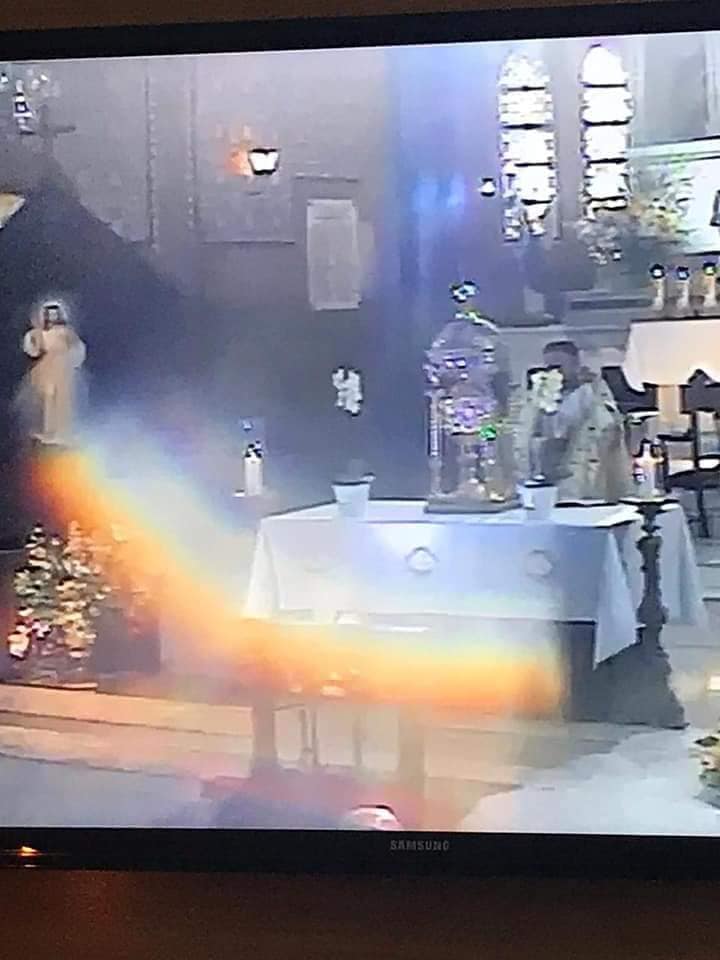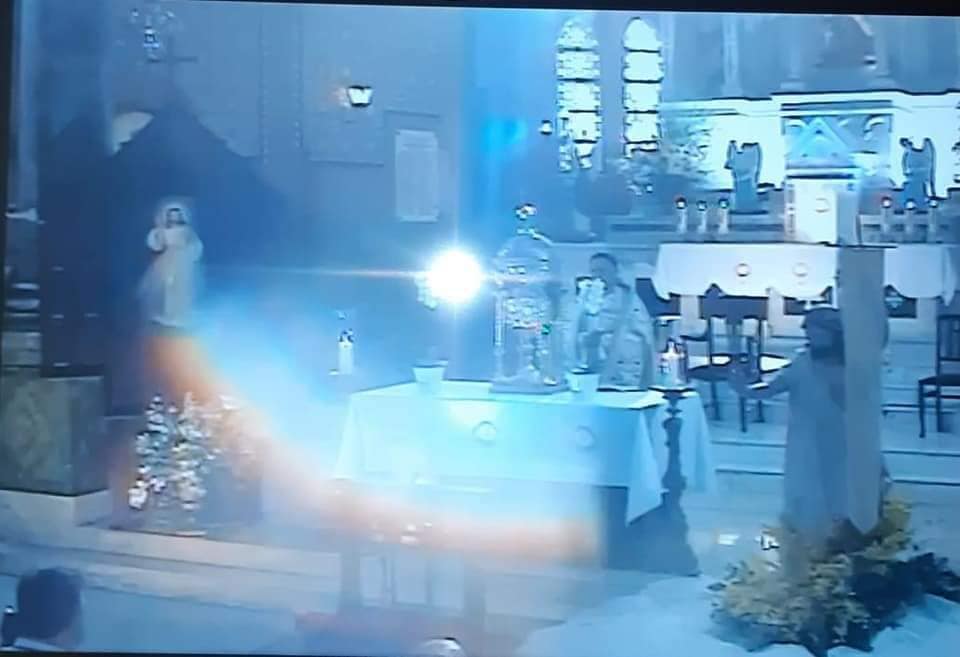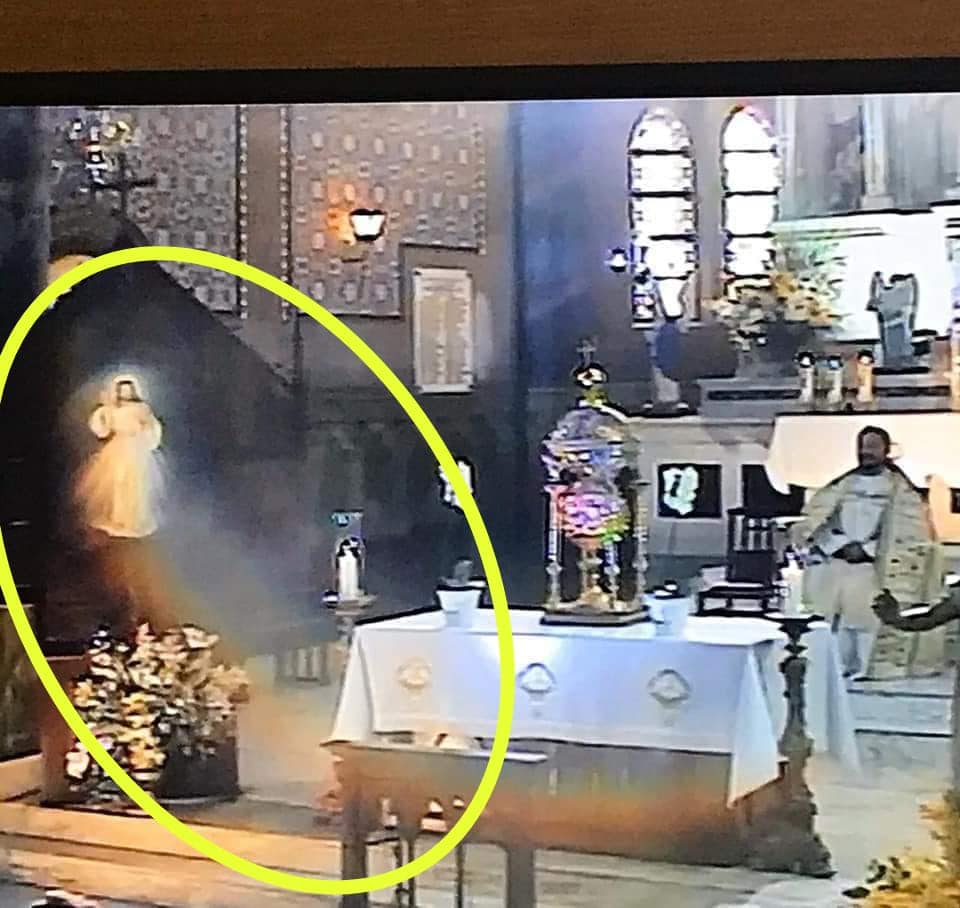Brief Overview
- On April 19, 2020, an event took place at St. John the Baptist Church in Bebedouro, São Paulo, Brazil, during Divine Mercy Sunday celebrations.
- A small group of faithful gathered at 3:00 pm to pray the Divine Mercy Chaplet, despite restrictions due to the global COVID-19 pandemic.
- During the homily, a parishioner took photos that later revealed an unusual image of light rays, sparking widespread interest.
- These photos are claimed by some to depict a supernatural phenomenon linked to the Divine Mercy devotion.
- The event has been shared widely online, with many Catholics seeing it as a sign of God’s mercy in a challenging year.
- This article examines the incident, its context within Catholic teaching, and its significance to the faithful.
Detailed Response
The Context of Divine Mercy Sunday
Divine Mercy Sunday, celebrated on the Second Sunday of Easter, holds a special place in the Catholic Church. Established by Pope John Paul II in 2000, it stems from the visions of St. Faustina Kowalska, a Polish nun who received messages from Jesus in the 1930s. Her diary records Christ’s desire for a feast to honor His mercy, promising graces to those who participate. The date of April 19, 2020, marked this feast during a time of global crisis caused by the COVID-19 pandemic. In Brazil, as elsewhere, public gatherings were limited, yet St. John the Baptist Church in Bebedouro opened its doors for a small group. The timing—3:00 pm—is significant, as it aligns with the Hour of Mercy, when St. Faustina was instructed to pray for God’s mercy on the world. This context frames the alleged miraculous photos as potentially meaningful to believers. The Church teaches that God’s mercy is always available, especially in times of suffering (see CCC 667). For many, the events in Bebedouro seemed to reflect this promise. Reports of the photos spread quickly, fueled by social media and Catholic news outlets.
The Event at St. John the Baptist Church
On April 19, 2020, a limited number of parishioners gathered at St. John the Baptist Church in Bebedouro, São Paulo, Brazil. The church, located in a small city about 400 kilometers northwest of São Paulo, held a prayer service focused on the Divine Mercy Chaplet. This devotion, given to St. Faustina, involves specific prayers asking for mercy, often recited at 3:00 pm. According to a Portuguese Facebook post, a priest delivered a homily explaining the rays of mercy described in St. Faustina’s visions—red and pale, symbolizing blood and water from Christ’s side (John 19:34). During this talk, one attendee took photographs inside the church. Later, upon reviewing the images, they noticed what appeared to be distinct rays of light not visible to the naked eye at the time. The post described the photographer’s shock and excitement, calling it a sign of “Jesus Misericordioso” (Merciful Jesus). No official statement from the parish or diocese has confirmed the event’s details. However, the photos circulated widely online, prompting discussion among Catholics globally. The lack of formal investigation leaves the incident open to personal interpretation.
Understanding the Rays of Divine Mercy
The rays captured in the photos connect directly to St. Faustina’s Divine Mercy image. In her visions, Jesus instructed her to have an image painted showing two rays—one red, the other pale—emanating from His heart. These rays represent the blood and water that flowed from Christ’s pierced side, a moment recounted in John 19:34. The red ray signifies the blood of the Eucharist, while the pale ray symbolizes the water of Baptism and Reconciliation (CCC 1225, 1439). St. Faustina wrote that Jesus explained these rays as a source of mercy for souls. The image, now iconic in Catholic devotion, is venerated worldwide, especially on Divine Mercy Sunday. In Bebedouro, the homily reportedly focused on this symbolism, making the appearance of similar rays in the photos striking to those present. Some see it as a visual echo of St. Faustina’s vision. Others caution that natural light or camera effects could explain the phenomenon. The Church encourages discernment in such cases, emphasizing faith over unverified signs (CCC 67).
The Role of Photography in Modern Faith
Photography has become a tool for documenting and sharing faith experiences in the digital age. In Bebedouro, the photos taken on April 19, 2020, served as the primary evidence of the alleged miracle. Unlike past eras, when miracles relied on eyewitness testimony, modern technology allows instant recording and dissemination. The parishioner’s decision to photograph the homily was spontaneous, not planned for a specific outcome. The resulting images, showing light rays, gained traction online, particularly among Catholic communities. This reflects a broader trend where visual media shapes religious narratives. The Church does not require photographic proof for miracles but evaluates them based on spiritual fruit and consistency with doctrine (CCC 66). In this case, the photos inspired devotion for some, while others questioned their authenticity. The event highlights how technology intersects with belief, amplifying personal experiences into global conversations. Still, the Church urges caution, prioritizing faith in Christ over reliance on images.
Catholic Teaching on Private Revelations
The Bebedouro photos fall under the category of private revelations in Catholic theology. Private revelations, like those of St. Faustina, are distinct from public revelation, which ended with the apostles (CCC 66). They are not binding on the faithful but can aid devotion if approved by Church authority. The Divine Mercy devotion itself received such approval, with St. Faustina canonized and her feast established. However, unverified events like the Bebedouro photos remain unofficial until investigated. The Church teaches that private revelations must align with Scripture and Tradition (CCC 67). If the photos depict a true sign, they could reinforce the Divine Mercy message. Yet, no formal inquiry by the Diocese of São Carlos, which oversees Bebedouro, has been reported as of April 2025. Without this, the event remains a personal testimony rather than a recognized miracle. Catholics are free to reflect on it but not obligated to accept it as divine.
Historical Precedents of Miraculous Signs
Miraculous signs have a long history in Catholicism, often tied to moments of crisis or devotion. The apparitions at Fatima in 1917, where the sun appeared to dance, occurred during World War I. Similarly, the Bebedouro event took place amid the COVID-19 pandemic, a time of global uncertainty. Past signs, like the stigmata of St. Francis of Assisi, were seen as confirmations of faith. The Church investigates such phenomena through rigorous processes, as with the Eucharistic miracles of Lanciano or Buenos Aires. In Brazil, a 2016 Eucharistic miracle in Tangará da Serra gained attention when a host appeared to bleed. The Bebedouro photos differ, lacking physical evidence beyond the images. Historically, approved miracles bear lasting spiritual impact (CCC 68). The Bebedouro case, while intriguing, awaits such evaluation. Its timing in 2020 may suggest a call to mercy, echoing past signs in troubled times.
The Local Setting: Bebedouro, Brazil
Bebedouro, a city of about 80,000 people, is not a major pilgrimage site but a typical Brazilian community. St. John the Baptist Church serves as a local parish under the Diocese of São Carlos. Its role on April 19, 2020, was modest—a small prayer gathering amid pandemic restrictions. Brazil has a strong Catholic heritage, with devotions like Divine Mercy widely practiced. The church’s decision to open reflected a pastoral need to offer hope during lockdown. The photos’ emergence from this setting adds a layer of humility to the story, contrasting with grander miracle narratives. Local culture may have amplified the event’s spread, as Brazilians often share faith experiences online. No records indicate prior supernatural claims at this church. The simplicity of the setting aligns with St. Faustina’s own humble origins. For locals, the photos became a point of pride and reflection.
Reactions from the Faithful
The response to the Bebedouro photos varied among Catholics worldwide. The original Portuguese post expressed awe, calling for mercy “on us and the whole world.” Shared on platforms like Facebook, it reached thousands, with comments praising God’s presence. Some saw it as a timely sign amid the pandemic, reinforcing trust in Divine Mercy. Others, including skeptics, suggested natural explanations like lens flares or reflections. Catholic forums debated its authenticity, with no consensus emerging. The lack of official Church comment left room for personal interpretation. For believers, the photos affirmed St. Faustina’s promise of mercy in suffering. Critics urged restraint, citing the need for investigation. The event’s viral nature shows how faith communities process signs in real time.
The Church’s Approach to Miracles
The Catholic Church approaches alleged miracles with caution and thoroughness. A diocesan bishop typically initiates an investigation, gathering testimony and evidence (CCC 67). For the Bebedouro photos, no such process has been documented by April 2025. Miracles must demonstrate supernatural origin and spiritual benefit, not merely coincidence. The Church distinguishes between public revelation and private signs, prioritizing the former (CCC 66). Approved miracles, like those of Lourdes, undergo years of scrutiny. The Bebedouro case, relying on photos, lacks the depth of evidence needed for formal review. Parish-level events often remain unexamined unless they gain significant attention. The faithful are encouraged to focus on Christ’s mercy, not unverified signs. This measured stance balances openness to God’s action with protection against error.
Theological Significance of Mercy in 2020
The year 2020 tested humanity with the COVID-19 pandemic, making mercy a pressing theme. Catholic teaching holds that God’s mercy flows abundantly in times of trial (CCC 2448). St. Faustina’s revelations emphasize this, promising grace to those who seek it on Divine Mercy Sunday. The Bebedouro photos, if genuine, could symbolize this mercy breaking through despair. The Hour of Mercy at 3:00 pm, when the photos were taken, ties directly to Christ’s death (John 19:30), a moment of ultimate mercy. The Church offered plenary indulgences that year for those confined by illness, amplifying the feast’s reach. For many, the photos reinforced hope in God’s presence. Theologically, mercy heals and redeems, a message resonant in 2020. Even without verification, the event invited reflection on this truth. It aligns with the Church’s call to trust in divine compassion.
Scientific Explanations and Faith
Some propose natural causes for the Bebedouro photos, such as light refraction or camera artifacts. Sunlight through a window, filtered by dust or glass, can create ray-like effects. Smartphone cameras, used by the parishioner, often produce anomalies in low light. Experts in photography note that lens flares mimic divine imagery in religious settings. The Church acknowledges such explanations, requiring miracles to exceed natural laws. Faith, however, does not depend on disproving science but on discerning God’s will (CCC 159). Believers argue the timing and context—during a Divine Mercy homily—suggest more than coincidence. Skeptics counter that human perception seeks meaning in random patterns. No scientific analysis of the photos has been reported. The tension between faith and reason remains, as Catholics weigh both.
The Role of St. Faustina’s Devotion
St. Faustina’s Divine Mercy devotion shapes the Bebedouro narrative. Her visions, recorded in the 1930s, gained papal approval under John Paul II. The chaplet, image, and feast she promoted focus on Christ’s mercy for sinners (CCC 1992). The Bebedouro event mirrors her emphasis on the 3:00 pm Hour of Mercy. The rays in the photos recall her vision, strengthening the devotion’s appeal. Catholics worldwide pray the chaplet, seeking grace promised by Jesus through her. The 2020 timing, amid a pandemic, heightened its relevance. For devotees, the photos affirm St. Faustina’s message. The Church sees her work as a gift, not a requirement, for faith (CCC 67). Bebedouro extends her legacy into a modern context.
Cultural Impact in Brazil
Brazil’s Catholic culture embraced the Bebedouro photos with enthusiasm. Social media amplified the story, reflecting the nation’s blend of faith and technology. Divine Mercy devotion already thrives there, with chaplets broadcast on radio and TV. The pandemic intensified spiritual hunger, making the photos a focal point. Local parishes reported increased interest in the feast post-2020. Brazil’s history of popular piety, like devotion to Our Lady of Aparecida, primed this response. The event fostered unity among the faithful, despite physical distancing. Critics within Brazil urged discernment, fearing superstition. No official Church stance has tempered the grassroots fervor. The photos became a cultural artifact of faith under pressure.
Comparing to Other Modern Miracles
The Bebedouro photos join a list of recent Catholic phenomena. The 1996 weeping statue in Civitavecchia, Italy, underwent diocesan review. A 2013 host in Poland, showing heart tissue, was scientifically tested. Bebedouro lacks such scrutiny, relying solely on images. Unlike Fatima’s mass-witnessed miracle, it was captured by one person. Its simplicity contrasts with dramatic signs like Guadalupe’s tilma. The Church approved those after decades; Bebedouro remains anecdotal. Common threads include timing during hardship and devotion to mercy or Mary. The photos’ impact is narrower, limited to online circles. They highlight how modern miracles adapt to digital evidence.
Discernment for the Faithful
Catholics discerning the Bebedouro photos should follow Church guidance. Private revelations enhance, not replace, core faith (CCC 67). Prayer and reflection, not fixation on signs, are key. The photos’ alignment with Divine Mercy devotion lends credibility to some. Yet, without investigation, certainty is impossible. The Church advises against rash judgment, promoting patience. Spiritual directors can help weigh personal experiences. The event’s fruit—renewed trust in mercy—matters more than its origin. Believers may find inspiration, but faith rests in Christ, not photos. Discernment balances openness with caution.
The Broader Message of Mercy
Beyond the photos, the Bebedouro event points to mercy’s universal call. Catholic teaching sees mercy as God’s response to human weakness (CCC 1846). St. Faustina’s revelations amplify this for modern times. The pandemic underscored humanity’s need for healing, mirrored in 2020’s challenges. The photos, verified or not, invite focus on this truth. Christ’s mercy, shown in Luke 15:20, seeks the lost. The Church offers this through sacraments, not just signs (CCC 1422). For Bebedouro’s faithful, the event was a reminder in dark times. It echoes the Gospel’s core: God meets us in suffering. This message outlasts any image.
Lack of Official Recognition
As of April 2025, the Bebedouro photos lack Church recognition. The Diocese of São Carlos has not commented publicly or launched an inquiry. This silence is typical for minor, local events. Major miracles, like Lourdes, required years of study. The photos’ spread online outpaced formal review, a modern challenge. Without diocesan action, they remain a private claim. The Church prioritizes doctrine over phenomena (CCC 66). Parishioners may cherish the memory, but it holds no official weight. Future investigation could shift this, though none is reported. For now, it’s a footnote in Catholic experience.
Implications for Divine Mercy Devotion
The Bebedouro photos bolster Divine Mercy’s popularity. They tie St. Faustina’s vision to a tangible moment, encouraging prayer. Devotees see them as validation of her promises. The event’s timing in 2020 deepened its resonance during hardship. Yet, the devotion stands independent of such signs (CCC 67). Its growth in Brazil reflects broader trends, not just this incident. The photos may inspire new adherents, but faith precedes them. The Church guards against over-reliance on the unverified. Mercy’s power lies in Christ, not images. Bebedouro adds a chapter, not a foundation, to this devotion.
A Call to Reflection
The Bebedouro photos invite Catholics to reflect on God’s mercy. They raise questions about signs in a digital age. Faith does not hinge on their authenticity but on Christ’s promises (John 3:16). The event’s simplicity—a small church, a few faithful—mirrors the Gospel’s quiet power. It challenges believers to seek mercy amid trial, as in 2020. The Church offers tools like the chaplet for this purpose. Whether miracle or coincidence, the photos stir thought. They remind us mercy transcends proof. Catholics can ponder them while rooted in doctrine. The call is to trust, not to judge.
Conclusion: Faith Over Phenomena
The Bebedouro photos of April 19, 2020, captured attention but remain unverified. They reflect a moment of hope in a difficult year, tied to Divine Mercy Sunday. Catholic teaching prioritizes faith in Christ over private signs (CCC 66). The event’s spread shows technology’s role in modern belief. Its meaning lies in personal response, not official status. Mercy, the Church teaches, flows from God, not photos (CCC 1996). St. Faustina’s devotion endures, with or without Bebedouro. The faithful can appreciate the story while focusing on the Gospel. It’s a prompt, not a pillar, of faith. God’s mercy, not images, sustains us.
The Miraculous Photos taken on Divine Mercy Sunday at 3:00 pm inside St. John the Baptist Church in Fountain, Brazil:



Signup for our Exclusive Newsletter
-

- Join us on Patreon for premium content
- Checkout these Catholic audiobooks
- Get FREE Rosary Book
- Follow us on Flipboard
Discover hidden wisdom in Catholic books; invaluable guides enriching faith and satisfying curiosity. Explore now! #CommissionsEarned
- The Early Church Was the Catholic Church
- The Case for Catholicism - Answers to Classic and Contemporary Protestant Objections
- Meeting the Protestant Challenge: How to Answer 50 Biblical Objections to Catholic Beliefs
As an Amazon Associate, I earn from qualifying purchases. Thank you.

